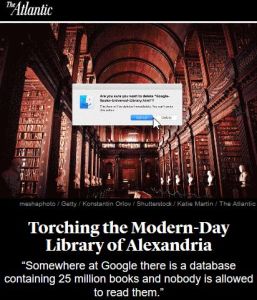Join getAbstract to access the summary!

Join getAbstract to access the summary!
James Somers
Torching the Modern-Day Library of Alexandria
“Somewhere at Google there is a database containing 25 million books and nobody is allowed to read them.”
The Atlantic, 2017
What's inside?
Google, countless work-hours and $400 million built the world’s best library that no one can use.
Recommendation
The original purpose of America’s copyright laws wasn’t necessarily to protect the interests of authors but, according to the US Constitution, “to promote the progress of science and useful arts.” Copyrights protect works until 50 years after the author’s death, at which point books become part of the public domain. Google has done the work to make many of those books available in one giant database, so why can’t you use it? getAbstract recommends this summary to bibliophiles, librarians and people interested in digital technology’s potential to democratize information.
Summary
About the Author
James Somers has written for The Atlantic, Outside Online, MIT Technology Review and Nautilus.

















Comment on this summary